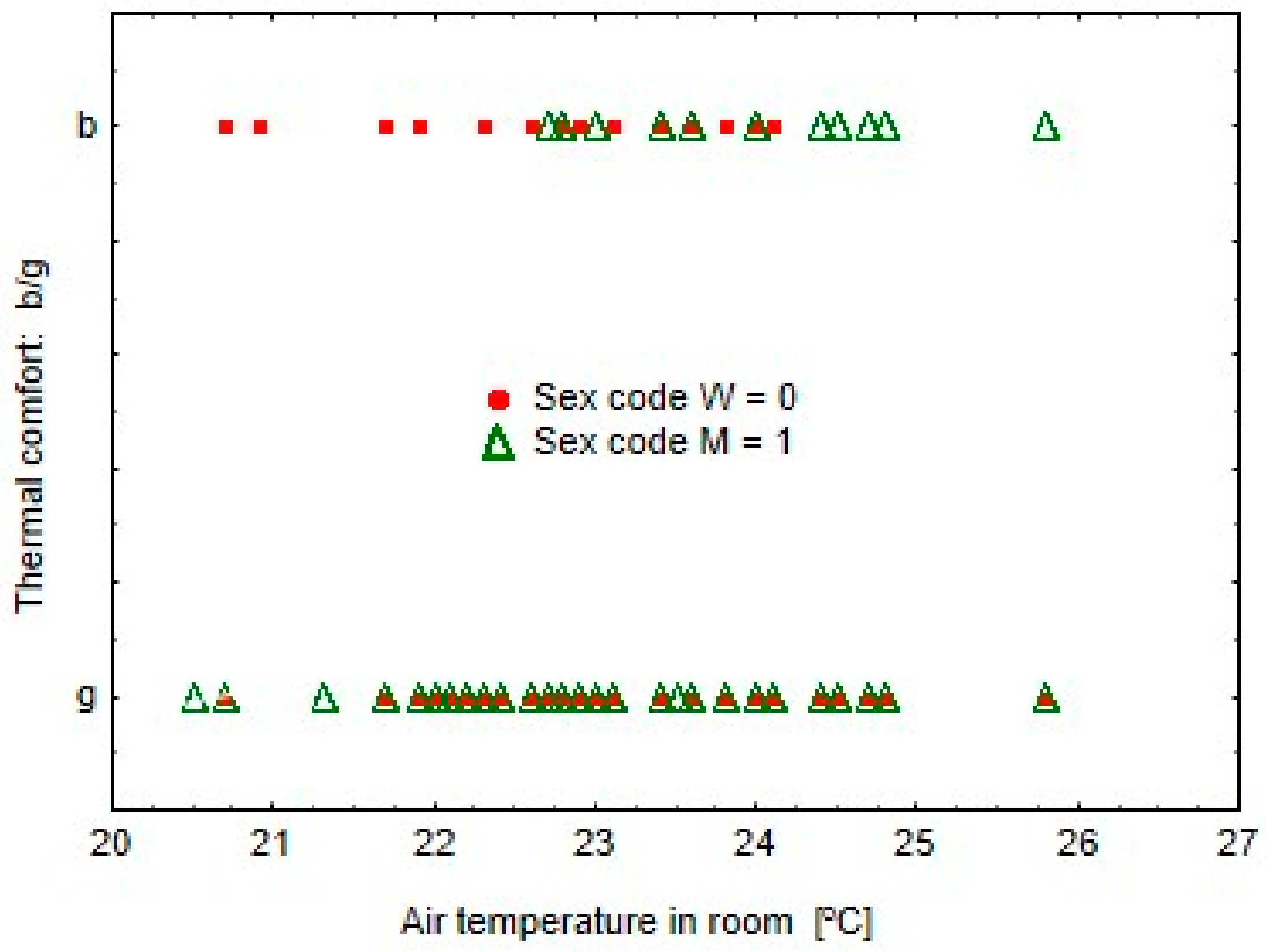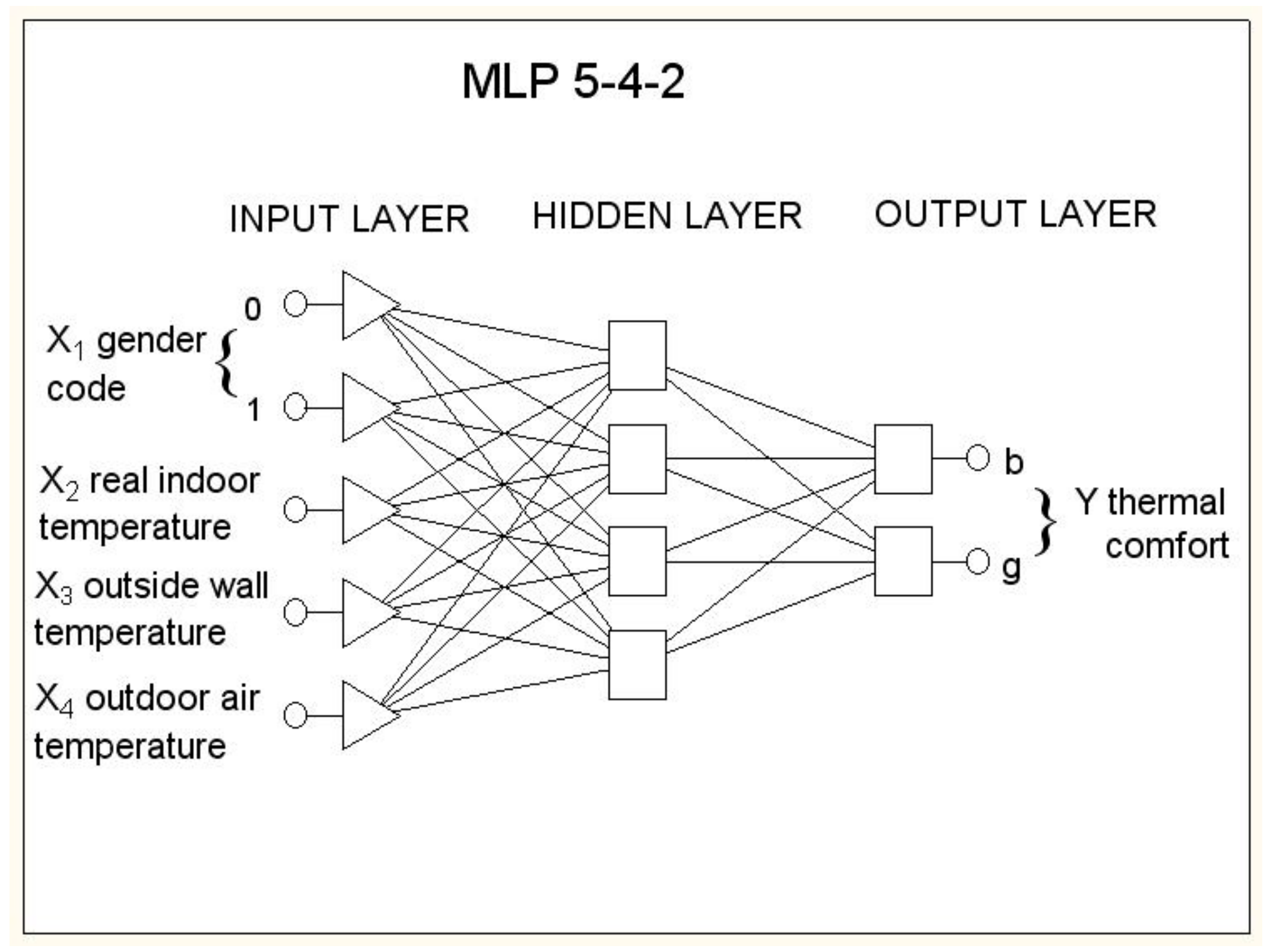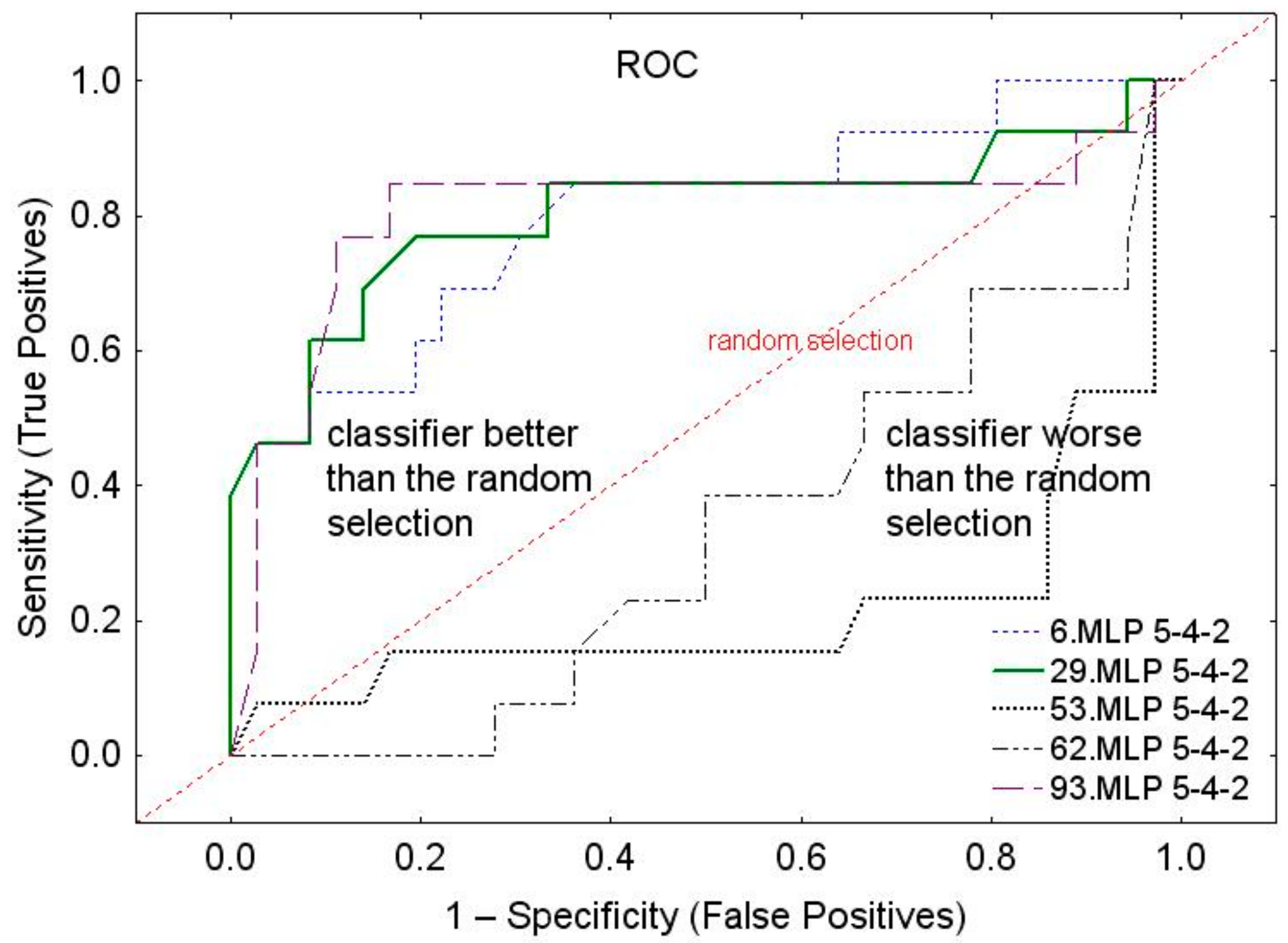Thermal Comfort Evaluation Using Linear Discriminant Analysis (LDA) and Artificial Neural Networks (ANNs)
Abstract
:1. Introduction
2. Materials and Methods
2.1. Experimental Research
2.2. Surveys
- Date of survey:
- Gender: W/M
- Comfort: bad (too cold or too hot); good (neither too cold nor too hot)
2.3. Limitations of the Research
2.4. Mathematical Tools Used in the Analysis of Research Results
2.4.1. Linear Discriminant Analysis (LDA)
2.4.2. Artificial Neural Networks (ANNs)
3. Results and Discussion
- (1)
- Qualitative variable: Y = b or g – assessment of thermal comfort, where: b – bad thermal comfort, g – good thermal comfort, with subsets’ content: nb = 52, ng = 281,
- (2)
- Qualitative variable: X1 ϵ [0,1] – respondent’s gender code: W or M, where: W = 0 for women, M = 1 for men, with subset’s content: nW = 199, nM = 134,
- (3)
- Quantitative variable: X2 ϵ [20.7 – 25.8 °C] – actual indoor air temperature,
- (4)
- Quantitative variable: X3 ϵ [19.5 – 25.7 °C] – external wall mean radiant temperature,
- (5)
- Quantitative variable: X4 ϵ [( + 3) – (+ 16.67) °C] – actual (real) outdoor air temperature.
- (i)
- Whether it is possible to distinguish one group from another (thermal comfort assessment as good or bad) on the basis of several variables (discriminatory);
- (ii)
- How well discriminatory variables distinguish group data?
- (iii)
- Which variables are best at discriminating?
4. Conclusions
Author Contributions
Funding
Acknowledgments
Conflicts of Interest
References
- Lia, Y.; Yuan, Y.; Li, C.; Han, X.; Zhang, X. Human responses to high air temperature, relative humidity and carbon dioxide concentration in underground refuge chamber. Build. Environ. 2018, 131, 53–62. [Google Scholar] [CrossRef]
- Ugranli, T.; Toprak, M.; Gursoy, G.; Cimrin, A.H.; Sofuoglu, S.C. Indoor environmental quality in chemistry and chemical engineering laboratories at Izmir Institute of Technology. Atmos. Pollut. Res. 2015, 6, 147–153. [Google Scholar] [CrossRef] [Green Version]
- Koelblen, B.; Psikuta, A.; Bogdan, A.; Annaheim, S.; Rossi, R.M. Thermal sensation models: Validation and sensitivity towards thermo-physiological parameters. Build. Environ. 2018, 130, 200–211. [Google Scholar] [CrossRef]
- Brągoszewska, E.; Mainka, A.; Pastuszka, J.S.; Lizończyk, K.; Desta, Y.G. Assessment of bacterial aerosol in a preschool, primary school and high school in Poland. Atmosphere 2018, 9, 87. [Google Scholar] [CrossRef] [Green Version]
- Canha, N.; Lage, J.; Candeias, S.; Alves, C.; Almeida, S.M. Indoor air quality during sleep under different ventilation patterns. Atmos. Pollut. Res. 2017, 8, 1132–1142. [Google Scholar] [CrossRef]
- ASHRAE Standard 55. Thermal Environment Conditions for Human Occupancy; American Society of Heating, Refrigerating and Air-Conditioning Engineers: Atlanta, GA, USA, 2004. [Google Scholar]
- De Dear, R.J.; Brager, G.S. Thermal comfort in naturally ventilated buildings: Revisions to ASHRAE Standard 55. Energy Build. 2002, 34, 549–561. [Google Scholar] [CrossRef] [Green Version]
- Doherty, T.J.; Arens, E. Evaluation of the physiological bases of thermal comfort models. ASHRAE Trans. 1988, 94, 15. [Google Scholar]
- Fanger, P.O. Calculation of thermal comfort: Introduction of a basic comfort equation. ASHRAE Trans. 1967, 73, 1–20. [Google Scholar]
- Fanger, P.O. Thermal Comfort, Analysis and Application in Environmental Engineering; Technical Press: Copenhagen, Denmark, 1970. [Google Scholar]
- Fanger, P.O. Thermal comfort. In Analysis and Applications in Environmental Engineering; McGraw-Hill: New York, NY, USA, 1972. [Google Scholar]
- Wang, Z. A field study of the thermal comfort in residential buildings in Harbin. Build. Environ. 2006, 43, 1034–1039. [Google Scholar] [CrossRef]
- Kingma, B.; van Marken, W. Energy consumption in buildings and female thermal demand. Clim. Chang. 2015, 5, 1054–1056. [Google Scholar] [CrossRef]
- Choia, J.-H.; Yeom, D. Development of the data-driven thermal satisfaction prediction model as a function of human physiological responses in a built environment. Build. Environ. 2019, 150, 206–218. [Google Scholar] [CrossRef]
- Hamzah, B.; Gou, Z.; Mulyadi, R.; Amin, S. Thermal Comfort Analyses of Secondary School Students in the Tropics. Buildings 2018, 8, 56. [Google Scholar] [CrossRef] [Green Version]
- Draganova, V.; Tsuzuki, K.; Nabeshima, Y. Field Study on Nationality Differences in Thermal Comfort of University Students in Dormitories during Winter in Japan. Buildings 2019, 9, 213. [Google Scholar] [CrossRef] [Green Version]
- Jindal, A. Investigation and analysis of thermal comfort in naturally ventilated secondary school classrooms in the composite climate of India. Archit. Sci. Rev. 2019, 62, 466–484. [Google Scholar] [CrossRef]
- Campano, M.A.; Pinto, A.; Acosta, I.; Muñoz-González, C. Analysis of the Perceived Thermal Comfort in a Portuguese Secondary School: Methodology and Results. Int. J. Eng. Technol. 2017, 9, 448–455. [Google Scholar] [CrossRef] [Green Version]
- Campano, M.A.; Domínguez-Amarillo, S.; Fernández-Agüera, J.; Sendra, J.J. Thermal Perception in Mild Climate: Adaptive Thermal Models for Schools. Sustainability 2019, 11, 3948. [Google Scholar] [CrossRef] [Green Version]
- Attaianese, E.; d’Ambrosio Alfano, F.R.; Palella, B.I. An Ergonomic Approach of IEQ Assessment: A Case Study. In Proceedings of the 20th Congress of the International Ergonomics Association (IEA 2018) Volume VIII: Ergonomics and Human Factors in Manufacturing, Agriculture, Building and Construction, Sustainable Development and Mining, Florence, Italy, 26–30 August 2019; pp. 504–513. [Google Scholar] [CrossRef]
- D’Ambrosio Alfano, F.R.; Ianniello, E.; Palella, B.I. PMV–PPD and Acceptability in Naturally Ventilated Schools. Build. Environ. 2013, 67, 129–137. [Google Scholar] [CrossRef]
- Sztulc, P. Badanie Temperatury Powietrza w Pomieszczeniu. Master’s Thesis, under direction Gładyszewska-Fiedoruk, K. Bialystok University of Technology, Bialystok, Poland, 2017. (In Polish). [Google Scholar]
- Pogoda. Available online: https://freemeteo.pl/pogoda/?language=polish&country=poland (accessed on 10 June 2019).
- Gładyszewska-Fiedoruk, K. Concentration of carbon dioxide in the cabin of a small passenger car. Transp. Res. Part D Transp. Environ. 2011, 16, 327–331. [Google Scholar] [CrossRef]
- Gładyszewska-Fiedoruk, K. Concentrations of carbon dioxide in a car. Transp. Res. Part D Transp. Environ. 2011, 16, 166–171. [Google Scholar] [CrossRef]
- Sulewska, M.J.; Gładyszewska-Fiedoruk, K.; Sztulc, P. Analysis of the results of empirical research and surveys of perceived indoor temperature depending on gender and seasons. Environ. Sci. Pollut. Res. 2018, 25, 31205–31218. [Google Scholar] [CrossRef] [Green Version]
- ASHRAE. Thermal Environmental Conditions for Human Occupancy; ANSI/ASHRAE Standard 55; ASHRAE: Atlanta, GA, USA, 2013. [Google Scholar]
- Yin, R.K. Case Study Research: Design and Methods, 4th ed.; SAGE Inc.: Thousand Oaks, CA, USA, 2017. [Google Scholar]
- Heathcoate, A.; Berne’s, E. Development of ego state theory: Where did it all begin and who influenced him? Trans. Anal. J. 2010, 40, 254–260. [Google Scholar]
- Stanisz, A. Przystępny Kurs Statystyki z Zastosowaniem STATISTICA PL na Przykładach z Medycyny; StatSoft Polska Sp. z.o.o.: Krakow, Poland, 2006. [Google Scholar]
- STATISTICA—Software Package; Polish Edition; StatSoft Polska Sp. z.o.o.: Krakow, Poland, 2002.
- Fisher, R.A. The use of multiple measurements in taxonomic problems. Ann. Eugen. 1936, 7, 179–188. [Google Scholar] [CrossRef]
- López-Chao, V.; Amado-Lorenzo, J.; Martin-Gutiérrez, J. Architectural Indoor Analysis: A Holistic Approach to Understand the Relation of Higher Education Classrooms and Academic Performance. Sustainability 2019, 11, 6558. [Google Scholar] [CrossRef] [Green Version]
- Haykin, S. Neural Networks. A Comprehensive Foundation; Prentice Hall International Inc.: Madison, WI, USA, 1999. [Google Scholar]
- Bishop, C.M. Neural Networks for Pattern Recognition; Clarendon Press: Oxford, UK, 1995. [Google Scholar]
- Sulewska, M.J.; Zabielska-Adamska, K. Data compression by principal component analysis (PCA) in modelling of soil density parameters based on soil granulation. Geol. Q. 2015, 59, 400–407. [Google Scholar] [CrossRef] [Green Version]
- Asfour, O.S.; Gadi, M.B. A comparison between CFD and Network models for predicting wind-driven ventilation in buildings. Build. Environ. 2007, 42, 4079–4085. [Google Scholar] [CrossRef]
- Sulewska, M.J.; Zabielska-Adamska, K. Dynamic CBR test to assess the soil compaction. J. Test. Eval. 2015, 43, 1028–1035. [Google Scholar]
- Yang, J.; Ni, S.; Weng, W. Modelling heat transfer and physiological responses of unclothed human body in hot environment by coupling CFD simulation with thermal model. Int. J. Therm. Sci. 2017, 120, 437–445. [Google Scholar] [CrossRef]
- Zhang, Z.; Kusiak, A.; Zeng, Y.; Wei, X. Modelling and optimization of a wastewater pumping system with data-mining methods. Appl. Energy 2016, 164, 303–311. [Google Scholar] [CrossRef]
- Villarrubia, G.; De Paz, J.F.; Chamoso, P.; De la Prieta, F. Artificial neural networks used in optimization problems. Neurocomputing 2018, 272, 10–16. [Google Scholar] [CrossRef]
- Qin, R.; Yan, D.; Zhou, X.; Jiang, Y. Research on a dynamic simulation method of atrium thermal environment based on neural network. Build. Environ. 2012, 50, 214–220. [Google Scholar] [CrossRef]








| Xi Variable | Wilk’s Lambda | Partial Wilk’s Lambda | Level p |
|---|---|---|---|
| X1 = Sex code | 0.9948 | 0.9985 | 0.48 > 0.05 |
| X2 = Real indoor air temperature | 0.9941 | 0.9991 | 0.59 > 0.05 |
| X3 = External wall mean radiant temperature | 0.9960 | 0.9972 | 0.34 > 0.05 |
| X4 = Real outdoor air temp. | 0.9941 | 0.9992 | 0.60 > 0.05 |
| Group Y = Thermal Comfort | Rows: Observed Classification; Columns: Predicted Classification | ||
|---|---|---|---|
| Correct Classification | g = 84.384% of All Cases | b = 15.616% of All Cases | |
| good | 100% | 281 | 0 |
| bad | 0% | 52 | 0 |
| Number of ANN 5-4-2 | Area Under ROC Curve (AUC) | ROC Threshold |
|---|---|---|
| 6 | 0.801 | 0.141 |
| 29 | 0.803 | 0.141 |
| 93 | 0.803 | 0.141 |
| 53 | 0.221 | 0.151 |
| 62 | 0.329 | 0.140 |
| ANN No. | In Validation Subset (V): Thermal Comfort | Entire Set: Thermal Comfort | ||||||||||
|---|---|---|---|---|---|---|---|---|---|---|---|---|
| Bad | Good | Bad | Good | |||||||||
| Total | Correct | In-Correct | Total | Correct | In-Correct | Total | Correct | In-Correct | Total | Correct | In-Correct | |
| 6 | 13 | 0 | 13 | 36 | 36 | 0 | 52 | 0 | 52 | 281 | 281 | 0 |
| 29 | 13 | 0 | 13 | 36 | 36 | 0 | 52 | 0 | 52 | 281 | 281 | 0 |
| 93 | 13 | 0 | 13 | 36 | 36 | 0 | 52 | 0 | 52 | 281 | 281 | 0 |
| 53 | 13 | 0 | 13 | 36 | 36 | 0 | 52 | 0 | 52 | 281 | 281 | 0 |
| 62 | 13 | 0 | 13 | 36 | 36 | 0 | 52 | 0 | 52 | 281 | 281 | 0 |
| Variable | Sex Code | Real Indoor Air Temperature | External Wall Mean Radiant Temperature | Real Outdoor Air Temperature |
|---|---|---|---|---|
| ANN No. | ||||
| 6 | 1.00047 | 0.99995 | 1.00006 | 1.00000 |
| 29 | 1.00106 | 1.00004 | 1.00002 | 1.00004 |
| 93 | 1.00088 | 1.00003 | 1.00014 | 1.00002 |
| 53 | 0.99974 | 0.99993 | 0.99998 | 0.99999 |
| 62 | 0.99990 | 1.00001 | 1.00006 | 0.99999 |
© 2020 by the authors. Licensee MDPI, Basel, Switzerland. This article is an open access article distributed under the terms and conditions of the Creative Commons Attribution (CC BY) license (http://creativecommons.org/licenses/by/4.0/).
Share and Cite
Gładyszewska-Fiedoruk, K.; Sulewska, M.J. Thermal Comfort Evaluation Using Linear Discriminant Analysis (LDA) and Artificial Neural Networks (ANNs). Energies 2020, 13, 538. https://doi.org/10.3390/en13030538
Gładyszewska-Fiedoruk K, Sulewska MJ. Thermal Comfort Evaluation Using Linear Discriminant Analysis (LDA) and Artificial Neural Networks (ANNs). Energies. 2020; 13(3):538. https://doi.org/10.3390/en13030538
Chicago/Turabian StyleGładyszewska-Fiedoruk, Katarzyna, and Maria Jolanta Sulewska. 2020. "Thermal Comfort Evaluation Using Linear Discriminant Analysis (LDA) and Artificial Neural Networks (ANNs)" Energies 13, no. 3: 538. https://doi.org/10.3390/en13030538
APA StyleGładyszewska-Fiedoruk, K., & Sulewska, M. J. (2020). Thermal Comfort Evaluation Using Linear Discriminant Analysis (LDA) and Artificial Neural Networks (ANNs). Energies, 13(3), 538. https://doi.org/10.3390/en13030538






